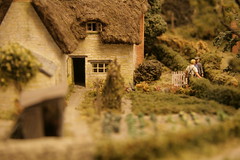For the last few months most of my longer weekend rides have aimed to reach a church on the list for my 2009 Jenkin's quest. My own rules demand that I cycle there and back, without using public transport. But now that I have completed the planned list for this year I am free to try other destinations, under different rules.
It has been so hot over the last week that I've wimped out, and not ridden the bike for several days. Today was cooler, and I wanted to cover a reasonable distance, without going too far. It seemed like a good idea to have a bit of a change for the destination.
I decided I would ride to Didcot, and get the train back, without much of an idea why, or what to do on the way.
On the way out I rode through Henley, which was crowded with visitors in blazers and posh frocks for the regatta (some in blazers, and some in frocks - none as far as I could see in both). Then I went through Stoke Row, where the Maharajah's well has been spruced up.
From there I followed National Cycle Route 5 through Wallingford, to Didcot. I hadn't realised it, but this route passes the Pendon model railway museum at Long Wittenham. So I stopped there for a look at the amazingly detailed models and recall one of the hobbies of my childhood. With another visit to the Didcot Railway Centre before catching the train home, it turned out to be a bit of a railway oriented trip.
I traced my route with the GPS, but I don't think there will be much to add to the Open Street Map. As far as the weather was concerned, I saw a bit of light rain between Stoke Row and Wallingford, but the day was mostly warm, with clouds clearing to blue sky later in the day.
Queuing with all the traffic in Henley was a bit of a pain, which I could have avoided if I had thought a but more carefully about the route. On the whole, though, it was a very pleasant day out. A bit different to my normal pattern, and none the worse for that.

2 comments:
As one grumpy old man to another may I take issue with you over calling Pendon a museum of model railways because it is not. It main objective, expressed right at the beginning by its founder, Roye England, is to recapture in model form, a specific pasrt of the English countryside as it was in the late 1920s/early 1930s. Railways there certainly are - they were the main means of transport at tnat time, especially of goods - but it is the buildings in the model village and its setting within a representation of the Vale of White Horse that are the museum's principal feature.
Fair comment. I did not do it justice. It is certainly a remarkable model.
Post a Comment